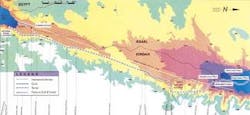By Koussai Quteishat
The Red to Dead Sea Conveyor (RDC) Project could solve serious water shortages in Jordan, Palestine and Israel, by using an ideal combination of renewable seawater and hydraulic energy.
By the year 2040, a deficit of more than 2,000 million cubic metres annually will severely affect Jordan, Israel and Palestine. Regional water scarcity problems thus require immediate attention. Except for fantastic, expensive and non-sovereign transport schemes, the only source for this water is desalination.
The RDC will transfer seawater from the Red Sea through a conveyance system, about 250 km in length, to the Dead Sea, which is nearly 410 metres below normal sea level. The difference in height will be used hydrostatically to desalinate incoming water to supply Jordan, Palestine and Israel with fresh water. The proposed reverse osmosis (RO) desalination will result in the largest RO plant in the world, producing about 850 million cubic metres per year.
The RDC project would also provide water needed to restore the Dead Sea to previous historic levels, replenish annually evaporated water, keep the balance of hydrologic systems and stabilise the rich ecosystem surrounding the Dead Sea.
Additionally, the Rift Valley, as a natural greenhouse with strong potential to produce off-season crops, can be further developed. Most importantly, however, international and regional cooperation needed to implement this project will be a solid step towards peace in the region.
The challenge of integrating energy-water-environment, the tripod for sustainable development, must be addressed through technological advancements. More research is necessary to address technical issues related to the desalination component of the project. The Middle East Desalination Research Centre (MEDRC), an international institution located in Muscat, Oman, is trying to make the desalination industry aware that the RDC project is viable and worth pursuing. The MEDRC will announce by mid-2003 several research projects in order to initiate the momentum needed for the industry to place this project on the drawing board. The research institution welcomes unsolicited proposals that aim to define and tackle any technical issues that may be forthcoming in such a scheme.
Thermal, solar, wind, nuclear, and tidal are all energy sources, at various stages of applicability, that are/can be used to produce desalinated water. Selection of one over the other is governed by many factors, including economical and environmental, which provide measures of sustainability. Gravity will power the Red to Dead Sea Conveyor project. Although common, hydraulic power is not usually associated with desalination since where hydraulic power prevails, relatively fresh water also prevails.
The MEDRC estimates that desalinating 850 million m3 using fuel or gas as an energy source would emit two to six million tons of carbon dioxide, 10,000 tons of oxides of nitrogen, 45,000 tons of sulphur dioxide and 1,000 to 3,000 tons of particulates into the atmosphere. Hydraulic power, a key element in the RDC project, would produce no such emissions.
Seawater is a renewable source of water. The dream, since desalination became a viable source of water supply, has been to have an economic and renewable source of energy that is also environmentally friendly. Using seawater and hydraulic energy, the Red to Dead Sea Conveyor (RDC) project would respond to these requirements for sustainability.
Author's noteKoussai Quteishat is the Director of the Middle East Desalination Research Center, located in Muscat, Oman.The Red - Dead ConveyorFacts and Figures• The salinity of the Dead Sea is ten times the normal sea salinity.• The Dead Sea is the lowest point on earth at about 410 meters (1360 ft) below sea level.• The level of the Dead Sea has been dropping at an annual rate of 0.5 to 1.0 meter for the last 40 years.• The surface area of the Dead Sea has decreased from 1000 to 669 km2 in the same period.• The length of the intended conveyor to transport water from the Red Sea to replenish the Dead Sea is about 250 km.• About 400 meters of static head can be used to power a reverse osmosis desalination plant.• Nearly 850 million cubic meters of desalinated water are to be produced for the benefit of the shoring nations.




